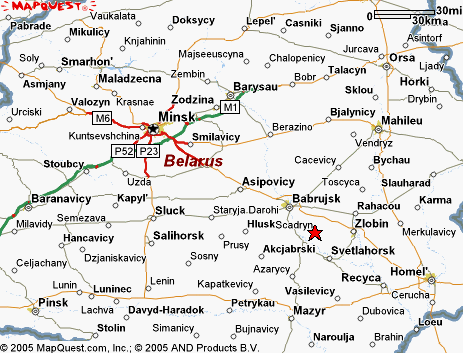


The Chabad shtetl of Shchedrin, latitude 52° 53′ North, Longitude 29° 33′ East, is one-hundred-eight miles southeast of the Belarusian city of Minsk, six miles from the Berezina River, and thirteen miles from the Dnieper. The Krasny-Bereg railway station, a stop on the Libava-Romny line, lies midway between Bobruisk and Gomel, and is eleven miles distant from Shchedrin. Bobruisk lies to the West, towards Germany and culture; Gomel lies to the East, towards Ukraine and Kiev and the Russian interior. Krasny-Bereg can be thought of as the way station between two very different cultures. (Taken from The History of the Family Golodetz by Dr. Lazar Golodetz, translated from the German by Dr. Shlomo Noble, Secretary, YIVO Commission on Research.)
In 1841, Chayyim Golodetz, a timber dealer, established a Jewish colony on the estate of Shchedrin. Some of the settlers engaged in general agriculture and some in the timber business of the Golodetz family. In 1897, there were 4,022 Jews in Shchedrin (95% of the total population of the town), about 40% of them engaging in agriculture. A decline in the Golodetz family resulted in a general emigration from the town.
In 1846, Rabbi Menachem Mendel, also known as the Tzemach Tzedek, purchased the 17 1/2 square kilometer estate of Schedrin. Rabbi Mendel arranged the settlement of sixty Jewish families on the estate, ceding each family a rent free agricultural allotment for twenty-five years. Families were provided with building materials and necessary farming equipment. Click here to read more about the Chabad shtetl.
In 1926 there were 1,759 Jews (91% of the total population) in Shchedrin. The Soviet government attempted to develop agriculture and in 1930 over half of the 380 remaining Jewish families were engaged in that occupation, about half of them living on the Kolkhoz, Sotsialistishe Veg ("Socialist Way", in Yiddish).
The Germans occupied Shchedrin in July 1941; the 1,500 Jews of Shchedrin were murdered in March 1942.
The shtetl of Shchedrin is known by a variety of names depending on the language used. Yiddish, Polish, Belarusian, and Russian are the primary languages that have been spoken in the region surrounding the shtetl. The English phonetic transliterations of the shtetl name, derived from each of these languages, are: